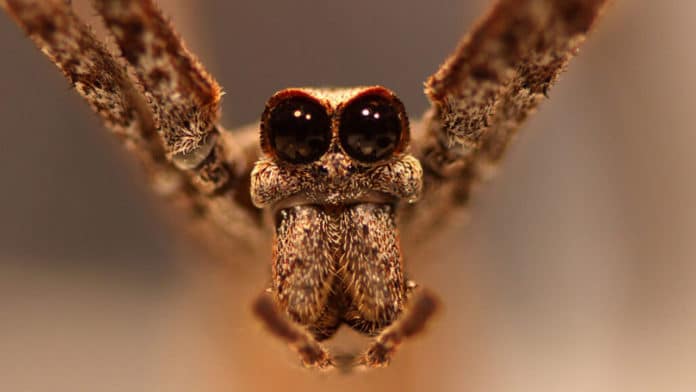Using a net held between their front four legs, ogre-faced, net-casting spiders lunge downward to ensnare prey from off the ground beneath them. But these spiders also can capture insects flying behind them with precision. Scientists have long wondered how do they do it.
Previous studies have hypothesized a vital role of acoustic sensitivity in the backward strike behavior of net-casting spiders, where spiders might locate prey by detecting acoustic cues produced by the flapping wings of flying insects.
A new study by the Cornell scientists suggests that these spiders use metatarsal sensitivity – sensors at the leg’s tip – to detect sound cues at various frequencies from up to 6 feet away. These signals trigger a brief moment, ninja-like backflip to strike unsuspecting airborne insects, bag them in a web net and then dine.
Ronald Hoy, the D & D Joslovitz Merksamer Professor in the Department of Neurobiology and Behavior in the College of Arts and Sciences, said, “These spiders have finely tuned sensory systems and a fascinating hunting strategy.”
“For these spiders, they’re doing a Willie Mays thing. Here comes a flying bug, and somehow, the spider gets information on the sound direction and distance. The spiders time the 200-millisecond leap if the fly is within its capture zone – much like an over-the-shoulder catch. The spider gets its prey. They’re accurate.”
To directly investigate net-casting spiders’ auditory detection abilities, scientists recorded neural activity from both their brains and their legs.
They played pure-tone frequencies to the spiders and noted the spider’s neurons became excited about different tones.
Scientists examined frequencies that ranged from 150 Hz to 750 Hz to 10 kHz.
While the spiders were sensitive to low-frequency tones, as expected, it was unexpected to see net-casting spiders sensitive to a wide range of frequencies – all the way to 10 kilohertz.
The study confirmed past research done by Charles Walcott, Ph.D. ’59, now professor emeritus in the Department of Neurobiology and Behavior. That study used oscilloscopes and other lab equipment and suggested that a spider’s metatarsal organ was sensitive to different frequencies of sound. At the time, European scientists had ridiculed the conclusion.
Walcott said, “Spiders are sensitive to airborne sound. That’s the big message.”
Other co-authors of the study include Gil Menda, Ph.D. ’14, Eyal I. Nitzany, Ph.D. ’15, a postdoctoral researcher at Northwestern University; and Eileen A. Hebets, professor of biological sciences at the University of Nebraska.
Journal Reference:
- Jay A. Stafstrom et al. Ogre-Faced, Net-Casting Spiders Use Auditory Cues to Detect Airborne Prey. DOI: 10.1016/j.cub.2020.09.048
